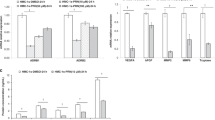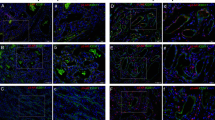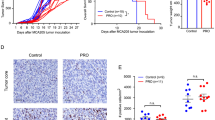Abstract
Background:
Infantile hemangioma (IH) is the most common tumor of infancy. The first-line therapy for IH is propranolol, a nonselective β-adrenergic receptor antagonist. However, mechanisms for the therapeutic effect of propranolol and regrowth of IH following cessation of treatment in some cases are not clear. We have recently shown that IH arises from multipotent stem cells. Whether IH stem cells are responsive to propranolol and are selectively targeted is unknown, and this is the focus of this study.
Methods:
IH stem cells were exposed to propranolol and were assayed for cellular and molecular alterations. We used endothelial cells (ECs) as controls and bone marrow–derived mesenchymal progenitor cells (bm-MPCs) as normal stem/progenitor counterparts to determine selectivity.
Results:
Our results show that propranolol significantly reduced IH stem cell growth but failed to induce caspase-3 activation. Normal bm-MPCs and mature ECs showed maintained or increased caspase-3 activation and significantly reduced cyclin-D1 levels. We further show that IH stem cells may escape apoptosis by inducing antiapoptotic pathways.
Conclusion:
This study reveals that propranolol does not induce apoptosis in IH stem cells, which is in contrast with the result for ECs. Escape from apoptosis in IH stem cells may involve induction of antiapoptotic pathways.
Similar content being viewed by others
Log in or create a free account to read this content
Gain free access to this article, as well as selected content from this journal and more on nature.com
or
References
Mulliken, J.B. & Glowacki, J. Hemangiomas and vascular malformations in infants and children: a classification based on endothelial characteristics. Plast. Reconstr. Surg. 69, 412–422 (1982).
Krol, A. & MacArthur, C.J. Congenital hemangiomas: rapidly involuting and noninvoluting congenital hemangiomas. Arch. Facial Plast. Surg. 7, 307–311 (2005).
Kleiman, A., Keats, E.C., Chan, N.G. & Khan, Z.A. Evolution of hemangioma endothelium. Exp. Mol. Pathol. 93, 264–272 (2012).
Frieden, I.J., Eichenfield, L.F., Esterly, N.B., Geronemus, R. & Mallory, S.B. Guidelines of care for hemangiomas of infancy. American Academy of Dermatology Guidelines/Outcomes Committee. J. Am. Acad. Dermatol. 37, 631–637 (1997).
Durr, M.L., Meyer, A.K., Huoh, K.C., Frieden, I.J. & Rosbe, K.W. Airway hemangiomas in PHACE syndrome. Laryngoscope 122, 2323–2329 (2012).
Léauté-Labrèze, C., Dumas de la Roque, E., Hubiche, T., Boralevi, F., Thambo, J.B. & Taïeb, A. Propranolol for severe hemangiomas of infancy. N. Engl. J. Med. 358, 2649–2651 (2008).
Price, C.J. et al. Propranolol vs corticosteroids for infantile hemangiomas: a multicenter retrospective analysis. Arch. Dermatol. 147, 1371–1376 (2011).
Richter, G.T. & Friedman, A.B. Hemangiomas and vascular malformations: current theory and management. Int. J. Pediatr. 2012, 645678 (2012).
Lamy, S., Lachambre, M.P., Lord-Dufour, S. & Béliveau, R. Propranolol suppresses angiogenesis in vitro: inhibition of proliferation, migration, and differentiation of endothelial cells. Vascul. Pharmacol. 53, 200–208 (2010).
Bingham, M.M., Saltzman, B., Vo, N.J. & Perkins, J.A. Propranolol reduces infantile hemangioma volume and vessel density. Otolaryngol. Head. Neck Surg. 147, 338–344 (2012).
Hogeling, M., Adams, S. & Wargon, O. A randomized controlled trial of propranolol for infantile hemangiomas. Pediatrics 128, e259–e266 (2011).
Stiles, J. et al. Propranolol treatment of infantile hemangioma endothelial cells: a molecular analysis. Exp. Ther. Med. 4, 594–604 (2012).
Ji, Y., Li, K., Xiao, X., Zheng, S., Xu, T. & Chen, S. Effects of propranolol on the proliferation and apoptosis of hemangioma-derived endothelial cells. J. Pediatr. Surg. 47, 2216–2223 (2012).
Porter, A.G. & Jänicke, R.U. Emerging roles of caspase-3 in apoptosis. Cell Death Differ. 6, 99–104 (1999).
Xiao, Q., Li, Q., Zhang, B. & Yu, W. Propranolol therapy of infantile hemangiomas: efficacy, adverse effects, and recurrence. Pediatr. Surg. Int. 29, 575–581 (2013).
Georgountzou, A., Karavitakis, E., Klimentopoulou, A., Xaidara, A. & Kakourou, T. Propranolol treatment for severe infantile hemangiomas: a single-centre 3-year experience. Acta Paediatr. 101, e469–e474 (2012).
Bagazgoitia, L., Hernández-Martín, A. & Torrelo, A. Recurrence of infantile hemangiomas treated with propranolol. Pediatr. Dermatol. 28, 658–662 (2011).
Khan, Z.A. et al. Multipotential stem cells recapitulate human infantile hemangioma in immunodeficient mice. J. Clin. Invest. 118, 2592–2599 (2008).
Ji, Y., Chen, S., Li, K., Xiao, X., Zheng, S. & Xu, T. The role of ß-adrenergic receptor signaling in the proliferation of hemangioma-derived endothelial cells. Cell Div. 8, 1 (2013).
Stacey, D.W. Cyclin D1 serves as a cell cycle regulatory switch in actively proliferating cells. Curr. Opin. Cell Biol. 15, 158–163 (2003).
Wong, A., Hardy, K.L., Kitajewski, A.M., Shawber, C.J., Kitajewski, J.K. & Wu, J.K. Propranolol accelerates adipogenesis in hemangioma stem cells and causes apoptosis of hemangioma endothelial cells. Plast. Reconstr. Surg. 130, 1012–1021 (2012).
Kermer, P., Klöcker, N., Labes, M. & Bähr, M. Insulin-like growth factor-I protects axotomized rat retinal ganglion cells from secondary death via PI3-K-dependent Akt phosphorylation and inhibition of caspase-3 In vivo. J. Neurosci. 20, 2–8 (2000).
Shimoke, K. & Chiba, H. Nerve growth factor prevents 1-methyl-4-phenyl-1,2,3,6-tetrahydropyridine-induced cell death via the Akt pathway by suppressing caspase-3-like activity using PC12 cells: relevance to therapeutical application for Parkinson’s disease. J. Neurosci. Res. 63, 402–409 (2001).
Barber, A.J. et al. Insulin rescues retinal neurons from apoptosis by a phosphatidylinositol 3-kinase/Akt-mediated mechanism that reduces the activation of caspase-3. J. Biol. Chem. 276, 32814–32821 (2001).
Mohan, S. et al. Involvement of NF-?B and Bcl2/Bax signaling pathways in the apoptosis of MCF7 cells induced by a xanthone compound Pyranocycloartobiloxanthone A. Phytomedicine 19, 1007–1015 (2012).
Kim, H.R. et al. FGF-2 inhibits TNF-a mediated apoptosis through upregulation of Bcl2-A1 and Bcl-xL in ATDC5 cells. BMB Rep. 45, 287–292 (2012).
Basile, J.R., Eichten, A., Zacny, V. & Münger, K. NF-kappaB-mediated induction of p21(Cip1/Waf1) by tumor necrosis factor alpha induces growth arrest and cytoprotection in normal human keratinocytes. Mol. Cancer Res. 1, 262–270 (2003).
Cheng, K. et al. Antiproliferative effect of tumor necrosis factor-alpha on human glioblastoma cells linked with cell cycle arrest in G1 phase. Neurol. Med. Chir. (Tokyo) 34, 274–278 (1994).
Hattori, T., Hayashi, H., Chiba, T. & Onozaki, K. Activation of two distinct anti-proliferative pathways, apoptosis and p38 MAP kinase-dependent cell cycle arrest, by tumor necrosis factor in human melanoma cell line A375. Eur. Cytokine Netw. 12, 244–252 (2001).
Communal, C., Singh, K., Sawyer, D.B. & Colucci, W.S. Opposing effects of beta(1)- and beta(2)-adrenergic receptors on cardiac myocyte apoptosis: role of a pertussis toxin-sensitive G protein. Circulation 100, 2210–2212 (1999).
Panjala, S.R., Jiang, Y., Kern, T.S., Thomas, S.A. & Steinle, J.J. Increased tumor necrosis factor-a, cleaved caspase 3 levels and insulin receptor substrate-1 phosphorylation in the ß1-adrenergic receptor knockout mouse. Mol. Vis. 17, 1822–1828 (2011).
Steinle, J.J., Booz, G.W., Meininger, C.J., Day, J.N. & Granger, H.J. Beta 3-adrenergic receptors regulate retinal endothelial cell migration and proliferation. J. Biol. Chem. 278, 20681–20686 (2003).
Keats, E. & Khan, Z.A. Unique responses of stem cell-derived vascular endothelial and mesenchymal cells to high levels of glucose. PLoS ONE 7, e38752 (2012).
Kleiman, A., Keats, E.C., Chan, N.G. & Khan, Z.A. Elevated IGF2 prevents leptin induction and terminal adipocyte differentiation in hemangioma stem cells. Exp. Mol. Pathol. 94, 126–136 (2013).
Roach, E.E. et al. Intrinsic regulation of hemangioma involution by platelet-derived growth factor. Cell Death Dis. 3, e328 (2012).
Author information
Authors and Affiliations
Corresponding author
Rights and permissions
About this article
Cite this article
Kum, J., Khan, Z. Propranolol inhibits growth of hemangioma-initiating cells but does not induce apoptosis. Pediatr Res 75, 381–388 (2014). https://doi.org/10.1038/pr.2013.231
Received:
Accepted:
Published:
Issue date:
DOI: https://doi.org/10.1038/pr.2013.231
This article is cited by
-
Infantile hemangiomas β3-adrenoceptor overexpression is associated with nonresponse to propranolol
Pediatric Research (2022)
-
Educational paper: therapy of infantile haemangioma—history and current state (part II)
European Journal of Pediatrics (2015)
-
Propranolol: Effectiveness and Failure in Infantile Cutaneous Hemangiomas
Drug Safety - Case Reports (2015)



